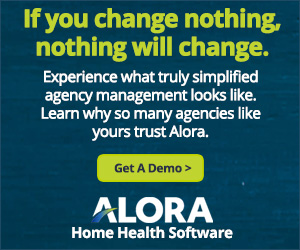
07 Jan Optimizing home health agency workflow with the best technology
Leveraging technology in home health care workflow
When caring for patients, time is not a passing commodity but a precious resource that requires careful management. Amidst the nature of home healthcare, optimizing workflow becomes more than just a convenience; it becomes an absolute necessity. This is where technology comes into play. Imagine technology as your companion, it’s meant to alleviate burdens and simplify the complexities of providing healthcare in someone’s home. The synergy between home healthcare professionals and digital tools is at the core of improving efficiency and patient outcomes.
In the fast-paced world of home health care, every decision can significantly affect the well-being of those in our care. We are focused on caring for the patient, managing many tasks, ensuring smooth coordination, and finding the right balance between efficiency and empathy.
For some agencies who are reluctant to adapt, the idea of throwing technology into the mix can be intimidating. The reality is that technology can serve as a companion ready to lend a hand and simplify the complexities of your daily routine. Technology isn’t a bystander or anything to be feared; it’s a force that can make seemingly overwhelming tasks a little less daunting.
Whether organizing appointments, keeping up with changing schedules, or facilitating communication, technology takes center stage as a helpful solution to some of the unique challenges of home healthcare. It can bring order to chaos and outdated processes and provide a proactive approach to getting things done most efficiently.
Assessing Current Workflow
Recognizing the obstacles that hold your agency back from embracing new technology is like exploring the landscape before starting a journey. It’s a step in creating a customized and efficient solution. Don’t be afraid to scrutinize and analyze your agency’s workflow practices, assessing each component thoroughly. Figure out which parts are working smoothly, and which could use some fine-tuning. Most importantly, an honest assessment of where the areas of friction or issues that reside in your agency operations will likely open the door to adopting at least a few technologies that previously have not been utilized.
This analysis process is not about assigning blame or dwelling on difficulties; instead, it’s an assessment aimed at understanding the complexities of your workflow. By identifying areas that may require some adjustments, you can establish the foundation for a streamlined system.
Leveraging Technology for Scheduling and Appointment Management
Mastering the complexities of scheduling in home healthcare is like solving a puzzle where the pieces are constantly moving. The changing nature of appointments, caregiver availability, and patient needs creates an environment that requires a flexible solution.
However, thanks to technology, you can say goodbye to missed appointments and the chaos of overbooked schedules. With specialized scheduling software, or even the integrated scheduling components of various home health software, you can enter a world of much greater efficiency. It’s all about reclaiming time, which allows you to concentrate on other areas that need more attention.
Electronic Health Records (EHR) Implementation
The piles of forms and meticulous documentation can feel like an unending maze that grows larger daily. Additionally, some agencies still operate on paper, or at least partially on paper. This could be due to budget, familiarity, or just a reluctance to rock the boat. In the world of Electronic Health Records (EHR software), there is a glimmer of hope that promises to ease the burden of paperwork and revolutionize how we handle patient records. In this era, EHR stands as a symbol of progress, offering healthcare professionals relief from the nature of traditional paperwork. It’s a game changer that frees you from the chains of record keeping in an era where accuracy, efficiency, and accessibility shape how we manage patient information. Read our blog on Choosing EHR software for home health agencies for more on this subject.
For many agencies, budget and ROI are key in the process of deciding to implement a new EHR software. Break-even analysis is always key for those operating under a restrictive budget. When calculating the true value of EHR software technology, factoring in and assigning dollar amounts to time saved for your staff (seriously, put an hourly number to it), can illuminate the value from a big-picture perspective. Additionally, many software applications have other features and components that can help with the broader spectrum of patient care, once again freeing up time to focus more on marketing your home care agency to attract new patients or possibly expanding your homecare options.
Mobile Technology for On-the-Go Caregivers is a Game Changer
One excellent game changer is the existence of apps specifically designed for caregivers. These apps are meticulously crafted to optimize efficiency and offer a range of functions that cater to the demands of providing care outside traditional healthcare settings. Many homecare software platforms offer a home health mobile app that allows caregivers to complete tasks within daily workflow, and administrators to manage agency operations. The ability to work without being bound to a desktop computer is another way to reclaim time, not to mention the convenience of it all.
Telehealth Solutions
Realistically, in this day and age, telehealth services are becoming almost a crucial part of delivering exceptional care, allowing agencies to provide top-notch healthcare services without the limitations of physical presence. The rise of telehealth during the pandemic is especially notable given the dangers of viral spread. It’s a very helpful technology that goes beyond boundaries, offering various innovative solutions from virtual consultations to remote monitoring, ultimately revolutionizing healthcare delivery. Telehealth serves as the bridge that connects healthcare professionals with patients in real-time discussions, allowing for symptom assessment and expert advice—all through the convenience of an efficient homecare telehealth platform.
Ten important technology aspects you can focus on to start a transition on tech-adoption
Once you start a conversation on buy-in, getting the true value out of homecare technology advancements requires proper use of the tools. If implemented and used poorly, they have the potential to cause frustration or even errors. Shift focus to these ten crucial things to bring home healthcare tech advancements to the forefront of your agency.
- Security and Privacy: It is vital to ensure that patient data is protected, and that privacy is maintained. Home Health companies can achieve safety by implementing security measures such as encryption and secure data storage. It is crucial to comply with regulations such as HIPAA and GDPR.
- Interoperability: It is important to ensure that devices and systems can work together seamlessly to avoid compatibility issues and to ensure that data is shared and accessed quickly and securely.
- User-centered design: It is vital to design and test the technology with patients, caregivers, and other users to ensure that it is easy to use and meets their needs.
- Training: It is important to provide training for healthcare professionals and patients on how to use the technology effectively. Training ensures that the technology is used correctly and that patients can take advantage of all its features.
- Implementation and Support: A proper implementation plan that includes testing, piloting, and adequate support for the technology is crucial for its success.
- Scalability: It is important to choose technology that can grow and adapt as the needs of the patients and the healthcare organization change over time.
- Flexibility: The technology should be flexible enough to adapt to diverse types of patients, different care settings, and different healthcare providers to ensure that a wide range of patients can use it.
- Evaluation and monitoring: It is important to evaluate the technology’s effectiveness and monitor its usage to identify any issues that may arise and make adjustments as needed.
- Cost-effective care: It is important to consider the cost of the technology and ensure that it is cost-effective for the healthcare organization and the patients.
- Impact on the workforce: As technology is integrated, it is essential to consider how it will impact the workforce and how healthcare professionals can be trained and supported to adapt to these changes.
Interoperability
Interoperability is critical for home health care providers, as it allows them to focus on their primary role of providing care and support to patients.
When devices and systems are not interoperable, healthcare professionals may spend considerable time trying to resolve compatibility issues. Problems with interoperability can take away from the time they have to spend with patients, leading to frustration and burnout among healthcare professionals.
Interoperability also helps to ensure that patient data is accurate, consistent, and up to date. When devices and systems are interoperable, sharing and accessing patient data can be more accessible, leading to inaccuracies and inconsistencies. This can negatively impact the quality of care and can also lead to misdiagnosis and other errors.
Interoperability can also improve communication between healthcare professionals, patients, and their families. Healthcare professionals can share patient data and collaborate more effectively with interoperable devices and systems. This can help to improve the patient’s experience, and it can also lead to better outcomes.
Training makes adoption so much easier…
Introducing technology to your team might seem overwhelming to some at first. Don’t worry! We have some strategies to make the process smooth and hassle-free. The key is to unlock the power of training programs that can transform those hesitant about technology into digital experts. One effective strategy is to develop training modules (or provide access to platforms where such modules already exist more broadly) that cater to different learning styles. Whether your team members prefer visual aids, hands-on activities, or auditory instructions, the training program can accommodate their preferences. This personalized approach ensures that every team member feels confident and comfortable navigating the landscape.
The Take away
Implementing scheduling software, Electronic Health Records (EHR), home health care software, mobile apps, EVV systems, and telehealth solutions are just some of the technologies that can strongly enhance the efficiency, accessibility, and quality of the home care services you offer. These digital innovations when paired with proper training, address the challenges faced by healthcare professionals and pave the way for a more patient-centered, responsive, and adaptable approach to caregiving.
We’ve all heard the buzz and the resistance with regards to AI, but keep an eye towards the future, as even more powerful new technologies are being introduced every year. Wearable devices, AI integrations, virtual reality applications (VR), and smart home technologies are just a few examples of innovations that are poised to help in an era where healthcare becomes not only proactive but also deeply personalized.
Author’s Note: Views, information, and guidance in this resource are intended for information only. We are not rendering legal, financial, accounting, medical, or other professional advice. Alora disclaims any liability to any third party and cannot make any guarantee related to the content.
Additional Home Health Agency blogs:

Alora’s home health software solution is ideal for agencies operating in both skilled and non-skilled care. Managing workflow for administrative and caregiving staff becomes easier with the right technology tools. Alora has been engineered with the goal of simplification of day-to-day tasks in the office and in the field, allowing agencies to focus on patient care and growth.



No Comments